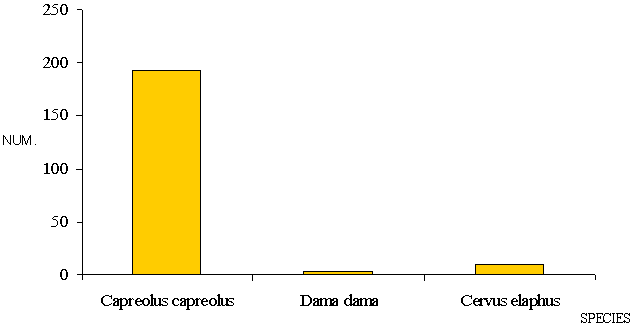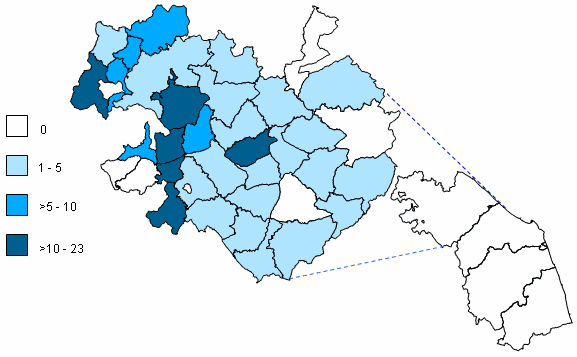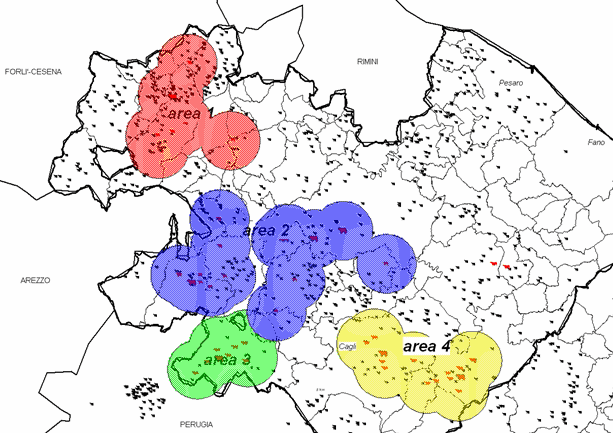Istituto Zooprofilattico Sperimentale dell'Umbria e delle Marche
Webzine Sanità Pubblica Veterinaria: Numero 40, Febbraio 2007 [http://www.spvet.it/]
Documento reperibile all'indirizzo: http://spvet.it/indice-spv.html#360
Serological monitoring of bluetongue virus in wild ruminants of the Pesaro-Urbino district (Italy) -
Monitoraggio sierologico del virus della bluetongue in ruminanti selvatici del distretto di Pesaro Urbino
De Curtis M., Bartolini C., Canonico C., Duranti A., Leoni F., Mancini P., Moscatelli F., Rocchegiani E. Gavaudan S.
Abstract: Bluetongue virus transmission between wild and domestic animals is a critic factor in order to carry out an effective sanitary control plan. The study evaluate circulation of Bluetongue in wild ruminants in Pesaro and Urbino area.
Our results show that in 206 samples of serum only one detected on fallow deer was positive. Prevalence of antibodies against Bluetongue virus in the targeted population of wild ruminants was very low, so they did not seem to have a role in Bluetongue spread in the Pesaro-Urbino area.
Introduction
Bluetongue virus infects both domestic and wild ruminants, but the relative epidemiological significance of the latter is still not fully clarified. Viral transmission between wild and domestic animals is an important factor to study, in order to carry out an efficient sanitary control plan.
Aim of the study
The aim of the study was to evaluate Bluetongue prevalence in wild ruminants of the Pesaro-Urbino district in the Central Italian region Marche, which was characterized, in 2004-2005, by a large circulation of the Bluetongue virus in domestic ruminants, especially due to vaccine serotype 2 (Fig. 3).
Materials and Methods
Target populaion: was represented by the whole population of wild ruminants of the Pesaro-Urbino district, which was estimated, by a local census, to be of 17.620.
Sampling: a random sample of ungulates in hunting areas of Pesaro-Urbino district was hunted and selected in summer 2004-2005.
Samples testing: samples of serum collected was analysed by an ELISA test to detect antibodies against Bluetongue virus. ELISA positive animals were further investigated for the presence of viral nucleic acid by an RT-PCR procedure performed on spleen and liver tissue samples
Case definition: an ungulate was considered positive if ELISA and RT-PCR assay were both positive.
Data analisys: MapInfo Professional v. 7.5 was used for geographical representation. Epi Info and Win Episcope 2.0 were used for statistical elaboration.
Fig. 2: Species and number of ungulates sampled

Results
206 ungulates among roe deer (Capreolus capreolus), fallow deer (Dama dama) and deer (Cervus elaphus) were hunted and selected in 31 of the 36 hunting areas of Pesaro-Urbino district (Fig. 1 and Fig. 2).
ELISA test detected antibodies against Bluetongue virus only in one fallow deer (apparent prevalence 0.49% I. C. 95% 0.12 – 1.77). The RT-PCR procedure employed did not detect viral RNA in the tissue samples examined (Tab 1). Prevalence of infection in wild ruminants, if present, was equal or lower than 1.44%.
Fig. 1: Hunting areas and number of ungulates selected in each one.

| Tab. 1: Prevalence observed |
| Ungulates population | Samples number | ELISA positive samples | ELISA+PCR positive samples | Maximun expected prevalence (I.C. 95%) |
| 17620 | 206 | 1 | 0 | < = 1.44 % |
Conclusions
Prevalence of antibodies against Bluetongue virus in the targeted population of wild ruminants was very low, although the high prevalence found in domestic ruminants in the same area and in the same period. Wild ruminants did not seem to have a role in Bluetongue viral circulation in the Pesaro-Urbino district.
Fig. 3: Areas of Pesaro-Urbino district with Bluetongue virus circulation in 2004-2005

References
- The use of a web-based interactive geographical information system for the surveillance of bluetongue in Italy”; Conte A., Colangeli P., Ippoliti C., Paladini C., Ambrosini M., Savini L., Dall’Acqua F., Calistri P.; Revue Scientifique and Tecnique 2005 Dec; 24(3): 857-68.
- Controlli sanitari su ungulati selvatici:uno strumento per migliorare la gestione sanitaria di animali domestici in alpeggio”; Andreoli E., Bianchi A., Bertoletti I., Scanziani E., Mattiello S.; Quaderno SOZOOALP n. 2 – 2005: 119-126.
- Considerazioni epidemiologiche sulla Blue Tongue in Liguria: sorveglianza entomologica e possibile ruolo dei selvatici”; Arossa C., Accorsi A., Barbarino A., Dellepiane M., Ercolini C., Mignone W., Migone L., Ferrari A.; Il Progresso Veterinario 11/2004: 430-434.



